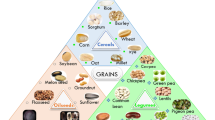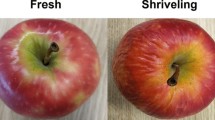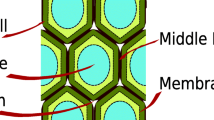Abstract
Major target of present paper is to investigate the drying kinetics of cornelian cherry fruits (Cornus mas L.) in a convective dryer, by varying the temperature and the velocity of drying air. Freshly harvested fruits are dried at drying air temperature of 35, 45 and 55 °C. The considered drying air velocities are V air = 1 and 1.5 m/s for each temperature. The required drying time is determined by taking into consideration the moisture ratio measurements. When the moisture ratio reaches up to 10 % at the selected drying air temperature, then the time is determined (t = 40–67 h). The moisture ratio, fruit temperature and energy requirement are presented as the functions of drying time. The lowest drying time (40 h) is obtained when the air temperature is 55 °C and air velocity is 1.5 m/s. The highest drying time (67 h) is found under the conditions of 35 °C temperature and 1 m/s velocity. Both the drying air temperature and the air velocity significantly affect the required energy for drying system. The minimum amount of required energy is found as 51.12 kWh, at 55 °C and 1 m/s, whilst the maximum energy requirement is 106.7 kWh, at 35 °C and 1.5 m/s. It is also found that, air temperature significantly influences the total drying time. Moreover, the energy consumption is decreasing with increasing air temperature. The effects of three parameters (air temperature, air velocity and drying time) on drying characteristics have also been analysed by means of analysis of variance method to show the effecting levels. The experimental results have a good agreement with the predicted ones.







Similar content being viewed by others
Abbreviations
- A :
-
Drying air flow surface area, m2
- c :
-
Specific heat of air under adiabatic conditions, J/kg K
- df :
-
Number of degrees of freedom
- D t :
-
Total drying time, h
- E t :
-
Total energy requirement of dryer, kWh
- F factor :
-
F test value of the factor
- k :
-
Number of factor’s level
- M w :
-
Weight of water in the product, g
- M T :
-
Total weight of product, g
- M k :
-
Dry weight of product, g
- M wb :
-
Moisture content according to wet basis, g/g
- M db :
-
Moisture content according to dry basis, g/g
- M t :
-
Weight at time t of product, g
- M t+Δt :
-
Weight at time t + Δt of product, g
- M 0 :
-
Initial weight of undried product, g
- M e :
-
Equilibrium moisture content of product, g water/g dry matter
- N :
-
Repeating number of each levels of factors
- n :
-
Number of experiments
- SS e :
-
Sum of square due to error
- SS factor :
-
Sum of square due to factor
- SS m :
-
Mean sum of square
- SS T :
-
Total sum of square
- S/N :
-
Signal to noise ratio, η
- ρ :
-
Air density, kg/m3
- ν :
-
Drying air speed, m/s
- V factor :
-
Variance of the factor
- W :
-
Drying air velocity, m/s
- W s :
-
Drying rate, g water/g dry matter h
- ΔT :
-
Temperature differences, K
- η factor−i :
-
Sum of ith level of factor
References
Sarsavadia PN (2007) Development of a solar-assisted dryer and evaluation of energy requirement for the drying of onion. Renew Energy 32:2529–2547
Moreira R, Chenlo F, Chaguri L, Vazquez G (2011) Air drying and colour characteristics of chestnuts pre-submitted to osmotic dehydration with sodium chloride. Food Bioprod Process 89:109–115
Thuwapanichayanan R, Prachayawarakorn S, Kunwisawa J, Soponronnarit S (2011) Determination of effective moisture diffusivity and assessment of quality attributes of banana slices during drying. LWT Food Sci Technol 44:1502–1510
Alibas I (2007) Microwave, air and combined microwave-air-drying parameters of pumpkin slices. LWT 40:1445–1451
Wang J, Sheng K (2006) Far-infrared and microwave drying of peach. LWT 39:247–255
Koyuncu T, Tosun I, Pinar Y (2007) Drying characteristics and heat energy requirement of cornelian cherry fruits (Cornus mas L.). J Food Eng 78:735–739
Kaya A, Aydin O (2010) Drying kinetics and sorption isotherms of cornelian cherry fruits. Desalin Water Treat 22:30–39
Güleryüz M, Bolat İ, Pırlak L (1998) Selection of table cornelian cherry (Cornus mas L.) types in Çoruh valley. Tr J Agric For 22:357–364
Demir F, Kalyoncu İH (2003) Some nutritional, pomological and physical properties of cornelian cherry (Cornus mass L.). J Food Eng 60:335–341
Hamid H, Yousef H, Jafar H, Mohammad A (2011) Antioxidant capacity and phytochemical properties of cornelian cherry (Cornus mas L.) genotypes in Iran. Sci Hortic 129:459–463
Klimenko S (2004) The cornelian cherry collection, preservation and utilization of genetic resources. J Fruit Ornam Plant Res 12:93–98
Ersoy N, Bagci Y, Gok V (2011) Antioxidant properties of 12 cornelian cherry fruit types (Cornus mas L.) selected from Turkey. Sci Res and Essay 6(1):98–102
Mamedov N, Craker LE (2004) Cornelian cherry: a prospective source for phytomedicine. In: Proceedings of the XXVI IHC-Future for medicinal and aromatic plants, Acta Hort 629. ISHS, Amherst, USA
Olszanska AN, Biesiada A, Letowska AS, Kucharska AZ (2011) Content of bioactive compounds and antioxidant capacity of pumpkin puree enriched with Japanese quince, cornelian cherry, strawberry and apples. Acta Scientiarum Polonorum Aliment 10(1):51–60
Togrul IT, Pehlivan D (2003) Modelling of drying kinetics of single apricot. J Food Eng 58:23–32
Akpinar E, Midilli A, Bicer Y (2003) Single layer drying behaviour of potato slices in a convective cyclone dryer and mathematical modelling. Energy Convers Manag 44:1689–1705
Evin D (2012) Thin layer drying kinetics of Gundelia tournefortii L. Food Bioprod Process 90:323–332
Zielinska M, Markowski M (2010) Air drying characteristics and moisture diffusivity of carrots. Chem Eng Process Process 49:212–218
Sacilik K, Elicin AK (2006) The thin layer drying characteristics of organic apple slices. J Food Eng 73:281–289
Koyuncu T, Serdar U, Tosun I (2004) Drying characteristics and energy requirement for dehydration of chestnuts (Castanea sativa mill.). J Food Eng 62:165–168
Tasirin SM, Kamarudin SK, Ghani JA, Lee KF (2007) Optimization of drying parameters of bird’s eye chilli in a fluidized bed dryer. J Food Eng 80:695–700
Celik N, Turgut E (2012) Design analysis of an experimental jet impingement study by using Taguchi method. Heat Mass Transf 48:1407–1413
Doymaz I (2007) Air drying characteristics of tomatoes. J Food Eng 78:1291–1297
Wang J, Xi YS (2005) Drying characteristics and drying quality of carrot using a two-stage microwave process. J Food Eng 68:505–511
Karim MA, Hawlader MNA (2005) Drying characteristics of banana: theoretical modelling and experimental validation. J Food Eng 70:35–45
Erdem M (2013) Experimental investigation of drying characteristics of fish in tray dryer. Master Thesis, 67 p (in Turkish)
Oztop MH, Sahin S, Sumnu G (2007) Optimization of microwave frying of potato slices by using Taguchi technique. J Food Eng 79:83–91
Moreno R, Antolin G, Reyes A (2006) Quality of fluidisation for the drying of forestry biomass particles in a fluidised bed. Biosyst Eng 94:47–56
Chen HH, Chung CC, Wang HY, Huang TC (2011) Application of Taguchi method to optimize extracted ginger oil in different drying conditions. Int Conf Food Eng Biotechnol 9:310–316
Author information
Authors and Affiliations
Corresponding author
Appendix
Appendix
Rights and permissions
About this article
Cite this article
Ozgen, F. Experimental investigation of drying characteristics of cornelian cherry fruits (Cornus mas L.). Heat Mass Transfer 51, 343–352 (2015). https://doi.org/10.1007/s00231-014-1397-y
Received:
Accepted:
Published:
Issue Date:
DOI: https://doi.org/10.1007/s00231-014-1397-y




